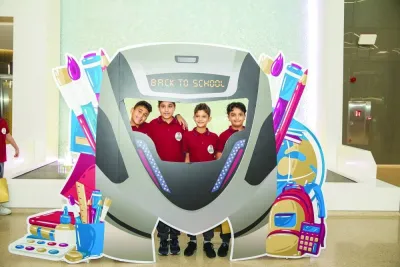Two years ago, Michelle Trujillo and her gravely ill 6-year-old daughter, Sophia, packed two suitcases and headed to the National Institutes of Health in Maryland for groundbreaking treatment they hoped would save the young girl’s life.
“It was definitely one of the hardest things to up and leave your house and everything you know,” Trujillo said. “But we had to do it.”
Last week, the mother and daughter returned to their Crystal Lake townhouse after a harrowing medical journey in which Sophia, now 8, defied the odds and became a tiny, tutu-wearing inspiration for doctors now studying her case.
No longer symptomatic of aplastic anaemia — a rare blood disorder that impaired Sophia’s immunity and would have been terminal without a blood transplant — the third-grader returned to school last Monday where she burst into tears of happiness as her best friends greeted her at the door.
“Everybody is going to be thrilled, but we’re also going to try to make it a normal part of her day because she wants to get back to normal,” said Julie Noonan, principal at St. Philip the Apostle School in Addison.
Her doctors and nurses at the NIH cheered her on in spirit.
“To see a little girl like her, who had something that in most cases that would’ve led to a fatality … to see her doing this well is incredibly rewarding,” said Dr Richard Childs, assistant US surgeon general and Sophia’s lead physician in Maryland.
Sophia Trujillo was featured in a 2015 Tribune story about the shortage of minority and multiracial bone marrow donors. Sophia is half Filipino, as well as Irish, Spanish and Italian.
After Sophia’s diagnosis, her mother co-ordinated donor drives across the US and put out passionate pleas on social media for mixed-race donors to be tested. But despite hundreds of people who stepped forward to be tested after the initial Tribune story, there was still no bone marrow match for Sophia.
The predicament highlighted a nationwide paradox that has troubled medical experts and families awaiting transplants for years: Despite growing diversity in the United States, there are not enough minority and multiracial donors registered and available for patients in need.
As time goes on, the mixes of races become even more prevalent and complicated as people from many races and ethnicities procreate.
Recognising the dilemma, a team of doctors in 2009 began a clinical trial at the NIH that treated multiracial aplastic anaemia patients with a procedure that created a match by combining the stem and umbilical cord cells of two different donors, Childs said.
By the time Sophia was accepted for the trial two years ago, 25 patients had been treated and 23 had survived — results that far exceeded the 70 percent survival rate doctors hypothesised when the research began.
Today, the clinical trial has an 84 percent survival rate after 30 patients received the transplants, Childs said.
But for the Trujillos, there were major setbacks before Sophia could return to good health.
Days before the process was to begin, Michelle Trujillo’s blood pressure rose to a level that forced the medical team to postpone her donation of stem cells for her daughter’s procedure.
Doctors monitored Trujillo’s vitals for two weeks until they considered her well enough for the donation. The mother’s stem cells were then combined with cells from an unknown umbilical cord donation from Taiwan for a procedure known as a haplo/cord stem cell transplant.
A few days after the transplant was complete, Sophia contracted an extremely rare fungal infection in her eye and surrounding area that is fatal in more than 80 percent of cases, Childs said.
“It was so unbelievably nerve-wracking, demoralising and depressing to have this infection that we were very worried was going to take her life happen to the cutest little girl that you’ve ever seen — with an incredibly proactive mom who had done everything to get the best care,” Childs said.
In an atypical medical move, Childs treated Sophia’s infection, called MUCOR, with granulocytes — or white blood cells — from her mother. The unconventional approach spared the young girl from a disfiguring surgery that is usually used to treat the infection.
Still, there was no guarantee Sophia would recover.
“There were days you could tell on the entire medical team’s faces,” Trujillo said. “You weren’t sure if she was going to make it to the next.”
After Sophia spent 30 days in the intensive care unit, her doctors were pleased to see the infection disappearing and the transplant working. But they kept her near the hospital so they could monitor her closely.
Michelle Trujillo found a new job in Maryland, which allowed her to work by her daughter’s bedside when necessary. The mother and daughter settled into an apartment, made friends and even hired a nanny — a recovering cancer patient — from the NIH, Trujillo said.
In between regular blood-count checks and eight follow-up surgeries to ensure the infection was gone, Sophia attended classes with other patients at a school inside the NIH.
But she missed the friends, ballet classes and family she left behind in the Chicago area.
“The difference was at NIH, my friends are all sick, and at home, my friends are all well,” said Sophia, who was given the green light by doctors to return home last week.
During one of her final checkups, Sophia surprised Childs by waiting for him on the paediatric floor wearing a miniature assistant surgeon general dress blues uniform her grandmother had made for her.
She stood in a salute and reminded him that she wants to be a doctor when she grows up — to help patients with aplastic anaemia, he said.
It was an emotional discovery for Childs, who expects Sophia to be off transplant medications within the next six months and to be free of the disease as she lives a normal life.
Last Monday, Michelle Trujillo wept as she drove away from her daughter’s school, and for much of the day while Sophia was away. But the tears came from a mix of happy emotions, she said.
“It was so great to see her embraced by everyone who has been praying so hard for her return,” Trujillo said. “I know that she is going to be amazing and go right back into normalcy. She can just be a child.” —Chicago Tribune/TNS

BACK TO CLASS: Sophia Trujillo, 8, looks over to classmate Giuliana Gallo, 8, during religion class on her first day of third grade at St. Philip the Apostle Catholic School in Addison, Illinois.


